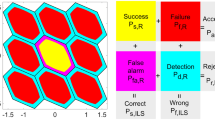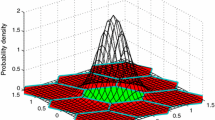Abstract
Carrier phase observations are required for high-accuracy positioning with Global Navigation Satellite Systems. This requires that the correct number of whole carrier cycles in each observation (integer ambiguity) is determined. The existing methods have been shown to perform differently depending on the observables. Subsequently, the ratio test used for ambiguity validation was developed further including combining it with the integer aperture concept. The key challenges in using the ratio test are the existence of biases in float solutions and stochastic dependence between the two elements of the ratio. The current methods either make assumptions of independence and nonexistence of biases or use simulations together with the bias-free assumption. We propose a new method taking into account both challenges which result in an unknown distribution of the ratio test statistic. A doubly non-central F distribution (DNCF) is proposed for the determination of threshold. The cumulative distribution function (CDF) of DNCF over-bounds the CDF of ratio test statistic distribution in case there is a bias in the float solution and a correlation between the two elements of the ratio. The Precise Point Positioning (PPP) method with products from CNES and measurement data from 10 NOAA stations are used to verify the proposed method. The test results show that the proposed method improves the performance of ambiguity resolution achieving a lower rate of wrong fixing than current state of the art.






Similar content being viewed by others
References
Bulgren WG (1971) On representations of the doubly non-central F distribution. J Am Stat Assoc 66(333):184–186
Euler HJ, Schaffrin B (1991) On a measure for the discernibility between different ambiguity solutions in the static-kinematic GPS-mode. In: Schwarz K-P, Lachapelle G (eds) IAG Symposia no 107, kinematic systems in geodesy, surveying, and remote sensing. Springer, Berlin, pp 285–295
Feng S, Ochieng WY, Walsh D, Ioannides R (2006) A measurement domain receiver autonomous integrity monitoring algorithm. GPS Solut 10(2):85–96
Feng S, Ochieng WY, Moore T, Hill C, Hide C (2009) Carrier-phase based integrity monitoring for high accuracy positioning. GPS Solut 13(1):13–22. doi:10.1007/s10291-008-0093-0
Feng S, Ochieng WY, Samson J, Tossaint M, Hernandez-Pajares M, Juan JM, Sanz J, Aragón-Àngel A, Ramos-Bosch P, Jofre M (2012) Integrity monitoring for carrier phase ambiguities. J Navig 65:41–58. doi:10.1017/S037346331100052X
Jokinen A, Feng S, Schuster W, Ochieng W, Hide C, Moore T, Hill C (2013) GLONASS aided GPS ambiguity fixed precise point positioning. J Navig 66(03):399–416
Leick A, Rapoport L, Tatarnikov D (2015) GPS satellite surveying, 3rd edn. Wiley, New York
Teunissen PJG (1995) The least-squares ambiguity decorrelation adjustment: a method for fast GPS ambiguity estimation. J Geod 70:65–82
Teunissen PJG and Verhagen S (2004) On the foundation of the popular ratio test for GNSS ambiguity resolution. In: Proceedings of ION GNSS. The Institute of Navigation, Long Beach, CA, 21–24 Sept, pp 2529–2540
Teunissen PJG, Verhagen S (2009a) GNSS carrier phase ambiguity resolution: challenges and open problems. Springer Berlin Heidelb Obs our Chang Earth 133(4):785–792
Teunissen PJG, Verhagen S (2009b) The GNSS ambiguity ratio-test revisited: a better way of using it. Surv Rev 41(312):138–151
Verhagen S (2004) Integer ambiguity validation: An open problem? GPS Solut 8(1):36–43
Verhagen S, Teunissen P (2006) On the probability density function of the GNSS ambiguity residuals. GPS Solut 10(1):21–28
Verhagen S, Teunissen P (2013) The ratio test for future GNSS ambiguity resolution. GPS Solut 17(4):535–548
Wang J, Stewart MP, Tsakiri M (2000) A comparative study of the integer ambiguity validation procedures. Earth Planets Space 52:813–817
Wei M and Schwarz KP (1995) Fast ambiguity resolution using an integer nonlinear programming method. In: Proceedings of ION GPS. The Institute of Navigation, Palm Springs CA, 12–15 Sept
Acknowledgments
This research was carried out mainly within iNsight (www.insight-gnss.org) and was partially supported by the National Natural Science Foundation of China (NSFC: 61328301). iNsight was a collaborative research project funded by the UK’s Engineering and Physical Sciences Research Council (EPSRC) to extend the applications and improve the efficiency of positioning through the exploitation of new global navigation satellite systems signals. It was undertaken by a consortium of thirteen UK universities and industrial groups: Imperial College London, University College London, University of Nottingham, University of Westminster, Air Semiconductor, EADS Astrium, Nottingham Scientific Ltd, Leica Geosystems, Ordnance Survey of Great Britain, QinetiQ, STMicroelectronics, Thales Research and Technology UK Limited, and the UK Civil Aviation Authority.
Author information
Authors and Affiliations
Corresponding author
Rights and permissions
About this article
Cite this article
Feng, S., Jokinen, A. Integer ambiguity validation in high accuracy GNSS positioning. GPS Solut 21, 79–87 (2017). https://doi.org/10.1007/s10291-015-0506-9
Received:
Accepted:
Published:
Issue Date:
DOI: https://doi.org/10.1007/s10291-015-0506-9




